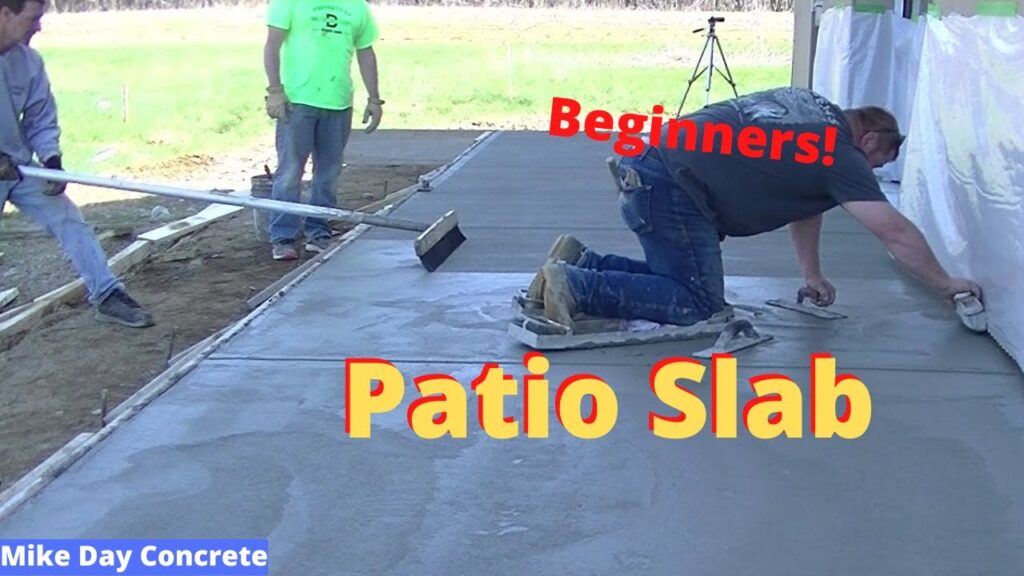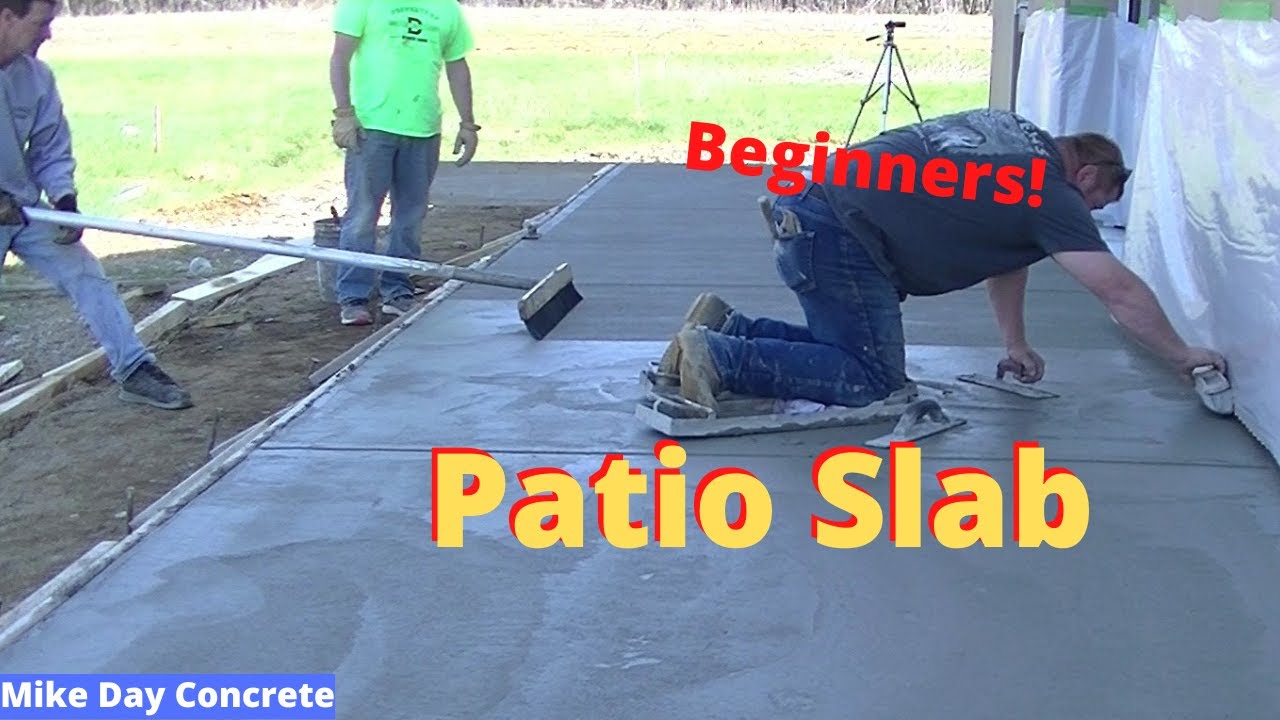
How to Pour a Concrete Patio: A Comprehensive Guide
Adding a concrete patio to your outdoor living space can significantly enhance its functionality and aesthetic appeal. A well-constructed concrete patio provides a durable and versatile surface for entertaining, relaxing, and enjoying the outdoors. This comprehensive guide will walk you through the entire process of how to pour concrete patio, from planning and preparation to pouring, finishing, and curing the concrete. Whether you’re a seasoned DIY enthusiast or a homeowner looking to tackle your first concrete project, this guide will provide you with the knowledge and confidence you need to create a beautiful and long-lasting concrete patio.
Planning and Preparation
Before you start mixing concrete, careful planning and preparation are essential. This stage sets the foundation for a successful project and ensures the final result meets your expectations.
Determine the Size and Shape
Consider how you plan to use your concrete patio. Will it be primarily for dining, lounging, or grilling? The size and shape should accommodate your intended activities and complement the existing landscape. Mark out the area using stakes and string, ensuring accurate measurements and square corners. Think about the placement of furniture and potential traffic flow to optimize the patio’s layout.
Check Local Building Codes and Permits
Before starting any construction project, it’s crucial to check local building codes and obtain any necessary permits. These regulations often dictate specific requirements for concrete patios, such as minimum thickness, setback distances from property lines, and drainage considerations. Contact your local building department to ensure compliance and avoid potential fines or delays.
Excavate the Area
Excavation involves removing the existing soil and vegetation to create a level base for your concrete patio. Dig down at least 6 inches, or more if you live in an area with frost heave. Ensure the excavation extends beyond the planned patio dimensions by a few inches on each side to accommodate the formwork. Remove any roots, rocks, or debris that could compromise the stability of the base. Proper excavation is critical for preventing cracking and settling in the future.
Compact the Subgrade
The subgrade is the soil layer beneath the base material. Compacting the subgrade is crucial for providing a stable and level foundation for your concrete patio. Use a plate compactor to thoroughly compact the soil, ensuring it is firm and dense. This process reduces the risk of settling and cracking in the concrete slab. Add soil if necessary to level out any low spots.
Add a Base Layer
A base layer of gravel or crushed stone provides drainage and prevents moisture from wicking up into the concrete. Spread a 4-inch layer of base material evenly over the compacted subgrade. Use a rake to distribute the material and a plate compactor to compact it thoroughly. A well-compacted base layer improves drainage and helps to prevent frost heave and cracking. This step is vital for the longevity of your concrete patio.
Build the Forms
Forms are temporary structures that define the shape and dimensions of your concrete patio. Use lumber, such as 2x4s or 2x6s, to construct the forms, ensuring they are level and securely staked in place. The top of the forms should be at the desired height of the finished patio. Use a level to check the forms and make any necessary adjustments. Secure the forms with stakes every 2-3 feet, using screws or nails. Proper formwork is essential for achieving a smooth and even surface.
Mixing and Pouring the Concrete
With the preparation complete, it’s time to mix and pour concrete patio. This stage requires careful attention to detail and a systematic approach.
Calculate Concrete Needs
Accurately calculating the amount of concrete needed is essential to avoid running short or ordering too much. Use a concrete calculator or the following formula: Length (feet) x Width (feet) x Thickness (feet) = Volume (cubic feet). Divide the result by 27 to convert to cubic yards. Add 5-10% for waste and variations in thickness. Ordering the correct amount of concrete saves time and money. A properly sized concrete patio begins with accurate calculations.
Mix the Concrete
You have two options for obtaining concrete: mixing it yourself or ordering ready-mix concrete from a supplier. Mixing concrete yourself is more labor-intensive but can be cost-effective for smaller projects. Use a concrete mixer or a wheelbarrow and shovel to combine the cement, sand, gravel, and water according to the manufacturer’s instructions. Ready-mix concrete is more convenient for larger projects and ensures a consistent mix. [See also: Choosing the Right Concrete Mix] Consider the size of your concrete patio when deciding which method is best.
Pour the Concrete
Begin pouring the concrete into the forms, starting in one corner and working your way across. Use a shovel to distribute the concrete evenly and ensure it fills all the corners and edges. Avoid pouring too much concrete in one spot, as this can create uneven settling. As you pour concrete patio, use a come-along or rake to level the surface roughly. Work methodically to ensure a consistent pour.
Screed the Concrete
Screeding is the process of leveling the concrete surface using a straight board or screed. Rest the screed on the forms and pull it across the surface with a sawing motion, removing excess concrete. This process creates a smooth and level surface. Fill in any low spots with additional concrete and repeat the screeding process. A well-screeded surface is essential for a professional-looking concrete patio.
Float the Concrete
Floating is the process of compacting and smoothing the concrete surface using a bull float or hand float. This process pushes down the aggregate and brings the cement paste to the surface. Float the concrete after the bleed water has evaporated and the surface is firm enough to support your weight. Over-floating can weaken the surface, so avoid excessive floating. A properly floated surface prepares the concrete for the final finishing steps. Ensuring you pour concrete patio correctly involves proper floating techniques.
Finishing and Curing the Concrete
The final steps of finishing and curing are crucial for achieving a durable and attractive concrete patio.
Edge and Joint the Concrete
Edging involves rounding the edges of the concrete slab using an edging tool. This prevents chipping and creates a more finished look. Run the edging tool along the edges of the forms, applying even pressure. Jointing involves creating control joints in the concrete slab using a groover or saw. These joints control cracking by providing a weak point for the concrete to crack along. Space control joints every 8-10 feet. Proper edging and jointing contribute to the longevity of your concrete patio.
Trowel the Concrete
Troweling is the process of smoothing the concrete surface using a trowel. This creates a smooth and dense surface. Trowel the concrete after the surface has hardened slightly. Use a steel trowel for a smooth finish or a broom for a textured finish. Avoid over-troweling, as this can weaken the surface. The type of trowel finish you choose will affect the overall appearance of your concrete patio.
Apply a Finish (Optional)
Various finishes can be applied to enhance the appearance and slip resistance of your concrete patio. Options include stamped concrete, exposed aggregate, and colored concrete. Stamped concrete involves pressing patterns into the surface using stamps. Exposed aggregate involves washing away the surface cement to reveal the aggregate beneath. Colored concrete involves adding pigments to the concrete mix to achieve a desired color. [See also: Decorative Concrete Finishes] Select a finish that complements your landscape and personal preferences.
Cure the Concrete
Curing is the process of keeping the concrete moist to allow it to hydrate properly and gain strength. This is the most critical step. Cure the concrete for at least 5-7 days. Keep the concrete patio moist by spraying it with water several times a day or covering it with plastic sheeting. Proper curing prevents cracking and ensures the concrete reaches its full strength. Ignoring this step can severely compromise the durability of your concrete patio.
Maintaining Your Concrete Patio
Once your concrete patio is complete, regular maintenance will help to keep it looking its best and extend its lifespan.
Clean Regularly
Clean your concrete patio regularly to remove dirt, debris, and stains. Sweep or hose off the surface regularly. For tougher stains, use a mild detergent and scrub brush. Avoid using harsh chemicals or abrasive cleaners, as these can damage the concrete. Regular cleaning will help to prevent stains from setting in and keep your patio looking fresh.
Seal the Concrete
Sealing your concrete patio provides protection against stains, moisture, and wear. Apply a concrete sealer every 1-2 years. Choose a sealer that is appropriate for your climate and the type of finish you have applied. Follow the manufacturer’s instructions carefully. Sealing helps to extend the lifespan of your patio and keep it looking its best.
Repair Cracks Promptly
Inspect your concrete patio regularly for cracks. Repair any cracks promptly to prevent them from spreading. Use a concrete crack filler to fill small cracks. For larger cracks, consult with a concrete professional. Addressing cracks early can prevent more significant damage and costly repairs. By following these steps, you can enjoy a beautiful and durable concrete patio for years to come.

